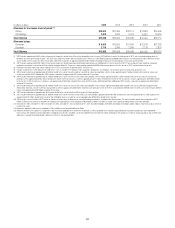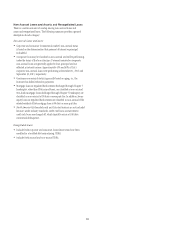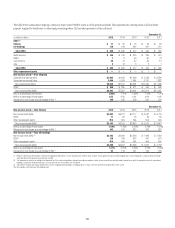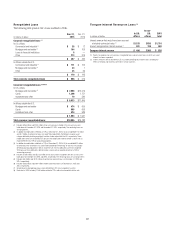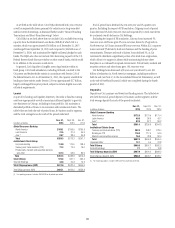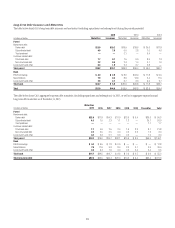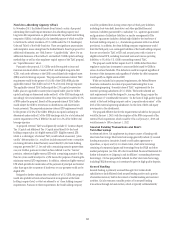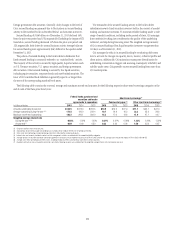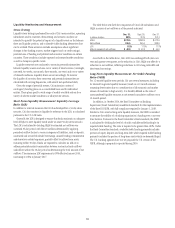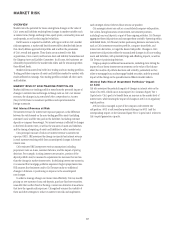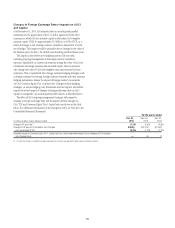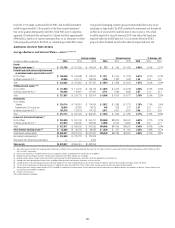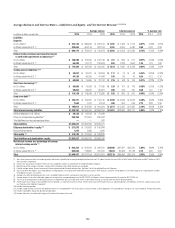Citibank 2015 Annual Report Download - page 110
Download and view the complete annual report
Please find page 110 of the 2015 Citibank annual report below. You can navigate through the pages in the report by either clicking on the pages listed below, or by using the keyword search tool below to find specific information within the annual report.92
Total Loss-Absorbing Capacity (TLAC)
In November 2015, the Federal Reserve Board issued a notice of proposed
rulemaking that would impose minimum loss-absorbing capacity and
long-term debt requirements on global systemically important bank holding
companies (GSIBs), including Citi, the intended purpose of which would be
to facilitate the orderly resolution of U.S. GSIBs under the U.S. Bankruptcy
Code and Title II of the Dodd-Frank Act. There are significant uncertainties
and interpretive issues arising from the Federal Reserve Board’s proposal. For
additional information, see “Risk Factors—Liquidity Risks” above. For an
additional discussion of the method 1 and method 2 GSIB capital surcharge
methodology as well as other regulatory capital aspects of the TLAC proposal,
see “Capital Resources” above.
Pursuant to the proposal, U.S. GSIBs would be required to issue and
maintain minimum levels of external TLAC and eligible long-term debt
(LTD), each set by reference to the GSIB’s consolidated risk-weighted assets
(RWA) and total leverage exposure. The proposed minimum external TLAC
requirement would be the greater of (i) 18% of the GSIB’s RWA plus the
applicable external TLAC buffer and (ii) 9.5% of its total leverage exposure.
The applicable external TLAC buffer equals the 2.5% capital conservation
buffer, plus any applicable countercyclical capital buffer, plus the GSIB’s
capital surcharge as determined under method 1 of the GSIB surcharge rule.
Accordingly, Citi’s total estimated current TLAC requirement would be 22.5%
of RWA under the proposal. Breach of the proposed external TLAC buffer
would subject the GSIB to restrictions on distributions and discretionary
bonus payments. The proposed minimum external LTD requirement would
be the greater of (i) 6% of the GSIB’s RWA plus its capital surcharge as
determined under method 2 of the GSIB surcharge rule, for a total estimated
current requirement of 9% of RWA for Citi and (ii) 4.5% of the GSIB’s total
leverage exposure.
As proposed, external TLAC would generally include (i) Common Equity
Tier 1 Capital and Additional Tier 1 Capital issued directly by the bank
holding company plus (ii) eligible external LTD. Eligible external LTD,
which is a subcategory of external TLAC, would include unsecured, “plain
vanilla” debt securities (i.e., would not include structured notes or securities
containing derivative-linked features) issued directly by the bank holding
company, governed by U.S. law and with a remaining maturity greater than
one year. Further, pursuant to what has been referred to as the “haircut”
provision, otherwise eligible external LTD with a remaining maturity of less
than two years would be subject to a 50% haircut for purposes of meeting the
minimum external LTD requirement. In addition, otherwise eligible external
LTD which provides for acceleration of the payment of principal and interest
other than upon the occurrence of insolvency or non-payment would not be
eligible LTD.
Designed to further enhance the resolvability of a U.S. GSIB, the proposal
would also prohibit or limit certain financial arrangements at the bank
holding company level, or what are referred to as “clean holding company”
requirements. Pursuant to these requirements, the bank holding company
would be prohibited from having certain types of third-party liabilities,
including short-term debt, derivatives and other qualified financial
contracts, liabilities guaranteed by a subsidiary (i.e., upstream guarantees)
and guarantees of subsidiary liabilities or similar arrangements if the
liability or guarantee includes a default right linked to the insolvency of
the bank holding company (i.e., downstream guarantees with cross default
provisions). In addition, the clean holding company requirements would
limit the third-party, non-contingent liabilities of the bank holding company
that are not related to TLAC or LTD and are pari passu with or junior to
eligible external LTD, including structured notes and various operating
liabilities, to 5% of the U.S. GSIB’s outstanding external TLAC.
The proposal would further require that U.S. GSIBs deduct from their
regulatory capital any investment in unsecured debt issued by GSIBs in
excess of certain thresholds. This deduction would be required regardless of
the tenor of the instrument and regardless of whether the debt instrument
would qualify as eligible external LTD.
While not included in its proposed requirements, the Federal Reserve
Board also indicated in its notice of proposed rulemaking that it was
considering imposing “domestic internal TLAC” requirements for the
material operating subsidiaries of U.S. GSIBs. The Board indicated any
such requirements would be designed to, among other things, require the
maintenance of “contributable resources” (in the form of high-quality liquid
assets) at the bank holding company and/or “prepositioned resources” at the
level of the material operating subsidiaries (in the form of debt and equity
investments in the subsidiaries).
The proposed effective date for the requirements included in the proposal
would be January 1, 2019, with the exception of the RWA component of the
external TLAC requirement, which would be 16% as of January 1, 2019 and
would increase to 18% on January 1, 2022.
Secured Funding Transactions and Short-
Term Borrowings
As referenced above, Citi supplements its primary sources of funding with
short-term borrowings. Short-term borrowings generally include (i) secured
funding transactions (securities loaned or sold under agreements to
repurchase, or repos) and (ii) to a lesser extent, short-term borrowings
consisting of commercial paper and borrowings from the FHLB and other
market participants (see Note 18 to the Consolidated Financial Statements for
further information on Citigroup’s and its affiliates’ outstanding short-term
borrowings). Citi has purposefully reduced its other short-term borrowings,
including FHLB borrowings, as it continued to grow its high-quality deposits.
Secured Funding
Secured funding is primarily accessed through Citi’s broker-dealer
subsidiaries to fund efficiently both secured lending activity and a portion
of securities inventory held in the context of market making and customer
activities. Citi also executes a smaller portion of its secured funding
transactions through its bank entities, which is typically collateralized by


